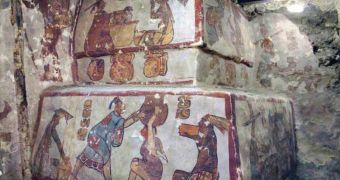One of the things that annoy archaeologists and historians most is the fact that ancient people were in the habit of presenting only the privileged few when designing artwork. Regardless of whether we're talking about papyrus scrolls, murals, paintings, music or text, there is always a certain group of people that is represented most, while the masses generally get lost around the way. Such a bias towards priests, kings, royals and army generals was also present in the ancient America civilization of the Mayans, but more recently researchers were able to discover some murals that depicted the lives of ordinary citizens, and not just that of the ruling class.
The site of Calakmul, Mexico, recently exposed one of its treasures to archaeologists, a 1,300-year-old mural that depicts former inhabitants of the city in daily postures, going about their chores. The thing that sets this particular mural apart from any others is that it doesn't show commoners serving the rich, wealthy and famous, but engaged in household activities. This is extremely important for historians, and the mural provides them with a wealth of data in this regard. At this point, this is the only known work of art from the pre-Columbian period that depicts such scenes. Digging at Mayan sites can be very instructive, but there's only so much information you can gather by doing this.
The investigators that dug at the location reported on a very interesting finding. They said that, as the years passed, the pyramid on which the mural was first created was expanded. This means that additional layers of building materials were added on top of the old ones. However, the builders took special interest in preserving the painting, as evidenced by the fact that the engraving was covered with a layer of packed mud, before constructors began expanding the original structure. The teams that dug at the site were coordinated by Ramon Carrasco Vargas, who is an expert at the Mexican National Institute of Anthropology and History, LiveScience reports.
The pyramid holding the murals was first unearthed in 2004, and since then archaeologists have been working on restoring it to its former glory. They now have to carefully remove the mud that was placed on top of the structure for protection. Thus far, the investigation has revealed numerous wonderful scenes from ancient Mayan life, including people making and dispensing food, and tradesmen going about their daily jobs. Some hieroglyphic inscriptions accompanying the murals featured captions identifying some of the individuals depicted according to their trade – dealing with salt, tobacco, or maize. Further details of the work appear in the latest issue of the respected journal Proceedings of the National Academy of Sciences.

 14 DAY TRIAL //
14 DAY TRIAL //